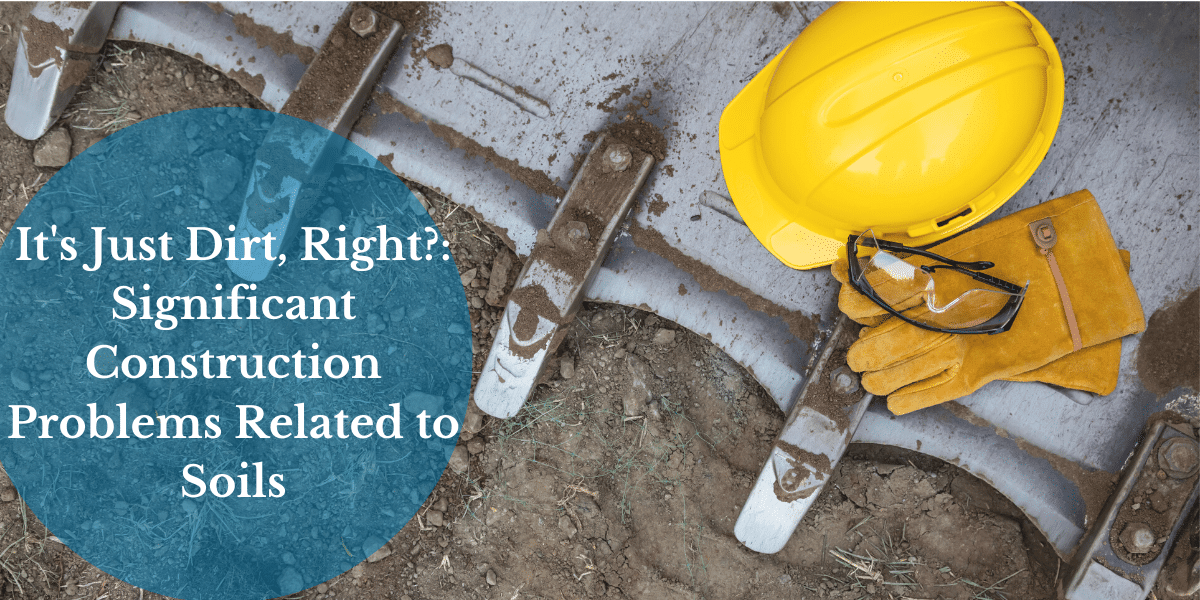
It’s Just Dirt, Right?: Significant Construction Problems Related to Soils
The common assumption seems to be that homes and condos are built on soil, all soil is the same, and there is no need to give a second thought to the soil. To the contrary, there are numerous soil problems that can damage a home or condo building, and if construction proceeds without the proper soil testing and preparation, those problems can cause serious damage years after construction is completed.
Soils and their ability to support a structure vary widely from one site to the next and can even have significant variations across one site or across a few feet of soil. The important characteristics of soil for construction purposes are the type and size of soil particles (sand, silt, or clay), the shape of the soil particles, and the amount of air and water in the soil.
The presence and amount of clay particles in a soil is of major significance to the engineering properties of that soil and its ability to support a structure. Once the clay content of a soil reaches around 25%, the other solid components of the soil (sand, silt, and rock) have no impact and the clay controls the engineering properties of the soil. Clay is so important because unlike other soil components, it experiences dramatic changes in its engineering properties as it is exposed to water. Water binds to clay particles and changes its properties, giving it a sticky, moldable quality when wet.
One problem caused by clay is that some clay soils expand significantly when the water content increases. These are known as expansive soils. When the water content in expansive soils increases, the soils expand with such force that they can lift foundations and cause serious structural damage. In the United States, the damage from expansive soils each year is estimated to be more than the combined costs of the damages from floods, hurricanes, tornadoes, and earthquakes. Expansive soils are known to exist in significant deposits in the Goose Creek, Moncks Corner, and Summerville areas as well as around Augusta, Florence, Columbia, and broadly across the Midlands and Pee Dee of South Carolina. Damage from expansive soils can be prevented by proper soil testing before beginning construction and by proper foundation design to accommodate for the expansive soils.
Soils can also cause problems when they settle under the weight of a building. In addition to the solid particles in soil, soil is made up of air and water that fills the spaces between the soil particles. As the weight of a structure presses down on soil over time, it can cause the particles to pack together more closely and squeeze air out of the soil. The result is that the soil settles down and the structure supported by it moves down with it. If all of the soil settled uniformly together, this would not be a problem. But soil does not settle uniformly, and some parts below a structure settle more than others. The result is that the foundation moves and cracks, and cracks and other damage occur to flooring, drywall, and other parts of the building above.
Soil settlement can be prevented through proper soil testing, soil compaction, and foundation design. Before any building is built, soil engineers called geotechnical engineers must test the soil to determine if it is sufficiently compacted and has sufficient strength (bearing capacity) to support the building to be constructed. If fill dirt is brought to the site or if the existing soil on the site is not sufficiently compacted, work has to be done to compact the soil. That work requires that the soil be in the proper condition, be placed in the correct way, and be subjected to enough compaction (usually through rolling and vibration) to achieve the required level of compaction. The soil then has to be tested again to ensure that the required level of compaction has been met. The failure to properly compact the soil can result in significant settlement damage and costly repairs for the owner of the building.
Soil settlement can also occur due to organic materials (anything that can rot away and usually roots or trees) being left in the soil. This settlement results from the organic material slowly decomposing in the soil and the soil collapsing into the space left by the decomposed material. This type of settlement can occur even where the soil has been properly compacted at the time of original construction. When preparing a site for construction, the builder must ensure that all of the organic material has been removed from the site and any fill dirt brought to the site does not have any organic material in it.
A third soil problem is the failure of soil slopes. A soil slope is any embankment or inclined area of soil. These slopes can fail, resulting in soil collapsing down the face of the slope. The failure can result in damage to a structure below the slope from the dirt sliding down into the structure. The failure can also result in damage to a structure above the slope from the structure losing support due to the soil moving away. Soil slope failures are generally a result of some combination of a slope that is too steep, gravity, the force of water seeping through the soil, and insufficiently compacted soil. Problems from slope failures can be avoided during original construction by locating structures the required distance away from slopes, by decreasing the angle of a slope or installing a retaining wall, by providing drainage systems to control the groundwater, and by sufficiently compacting the soil.




















